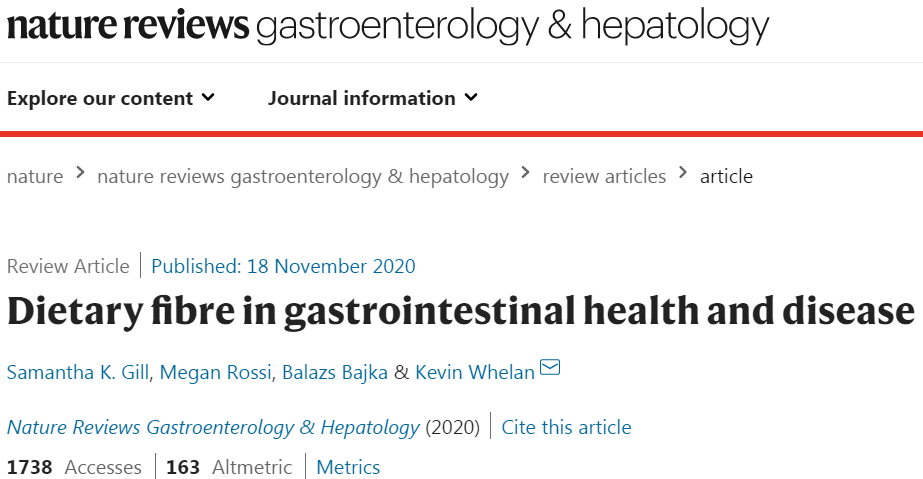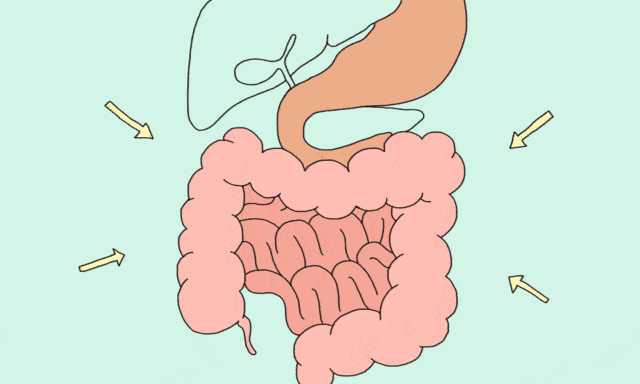
Nutritionists have long regarded sugar, protein, fat, vitamins, minerals, and water as the six major nutrients of a diet.
In the 1970s, scientists surveyed and found that the incidence of bowel cancer, diabetes, gallstone disease, coronary heart disease, obesity and other diseases in certain African countries was much lower than that of European and American countries. Later, it was discovered that this was “dietary fiber” credit.

Recently, the British journal Nature Reviews Gastroenterology and Hepatology published a review article detailing the important role of dietary fiber in disease prevention and treatment, especially its role in relieving gastrointestinal diseases.
Nature magazine once again praised “dietary fiber”
In terms of scientific definition, dietary fiber refers to sugars in plants that cannot be digested and utilized by the human body. Generally speaking, it is those parts of plant foods that are coarser in texture and difficult to chew and digest, such as the skins of fruits and the “gluten” in vegetables.

This review article mentioned that dietary fiber has important links with the development, treatment and death of many diseases.
Intake of dietary fiber can enhance the intestinal ability to take in key elements such as iron, zinc and calcium;
Intake of dietary fiber can also effectively regulate the abnormal intestinal transit time. For every gram of wheat fiber consumed, the intestinal transit time can be reduced by 0.78 hours;
Almost all types of dietary fiber can promote defecation and maintain the stability of defecation.
In addition to maintaining intestinal health, dietary fiber is also an undisputed “all-rounder”.
In 2015, a meta-analysis conducted by the British Nutrition Science Advisory Committee found that for every 7 grams of dietary fiber consumed daily through food, the risk of cardiovascular disease was reduced by 9%, the risk of stroke was reduced by 7%, and the risk of colorectal cancer was reduced. 8%, the risk of rectal cancer is reduced by 9%, and the risk of diabetes is reduced by 6%.

In 2019, a study comparing more than 230 previous studies covering 215,000 people showed that for every 8 grams of fiber consumed per day, the incidence of heart disease, type 2 diabetes, and bowel cancer can be reduced by 5% ~27%.
In 2019, another meta-analysis of 185 epidemiological cohort studies included that a daily intake of 25 to 29 grams of dietary fiber reduced the all-cause mortality of study participants by 15% and coronary heart disease mortality by 31%.
In summary, dietary fiber has many health benefits:
Promote bowel movements and maintain intestinal health;
Reduce the rate of blood sugar rise;
Inhibit cholesterol absorption;
Increase satiety and control weight;
Reduce the risk of bowel cancer, heart disease, diabetes, fatty liver and other diseases.
Unfortunately, at present, the daily dietary fiber intake of adults is generally insufficient (less than 20 grams) worldwide.
According to the Reference Intake of Dietary Nutrients for Chinese Residents (2013 Edition), adults should eat 25-30 grams of dietary fiber per day. However, the survey shows that my country’s per capita dietary fiber intake is only 10.8 grams, which is far below the relevant standards.
Dietary fiber, which food is hidden in?
Appropriate intake of dietary fiber will benefit the intestinal, cardiovascular, and metabolic levels. The following three types of foods are “big fiber consumers”, so you might as well eat more.
Whole grains, miscellaneous beans, potatoes
Such foods include brown rice, oatmeal, chickpeas, red beans, mung beans, etc.
The dietary fiber content of whole grains is generally more than 3%, and most of miscellaneous beans are more than 5%. Potatoes are not as high as whole grains and miscellaneous beans, but are also more than 1%.
In contrast, the dietary fiber content of rice is only 0.7%.

Vegetables and fruits
The dietary fiber in vegetables is between 1% and 5%. Among them, fungi have obvious advantages. Fresh shiitake mushrooms (3.3%), enoki mushrooms (2.7%), and fungus (2.6%) are all leaders that are rich in dietary fiber.
Fresh beans are also very good, such as edamame (4%), broad beans (3.1%), peas (3%), etc.
There are also many fiber masters in fruits, such as Korla pear (6.7%), pomegranate (4.8%), mulberry (4.1%), kiwi (2.6%), fresh date (1.9%), mango (1.3%), etc.
The elderly or children with poor gastrointestinal conditions can steam the fruit before eating it, and the dietary fiber will not be affected.
It should be noted that many people like to drink fruit juice, but the dietary fiber (pomace) is filtered out when squeezing the juice, which greatly reduces the health effect.

Nuts, soybeans
The dietary fiber content of nuts is mostly 4%~11%, and some such as black sesame and pine nuts are as high as 14% and 12.4% respectively. However, nuts generally contain higher fats, so you must control the amount when you eat them. About 10 grams per day is enough.
The dietary fiber content of dried soybeans is above 10%, which means that there are at least 5 grams of dietary fiber in a tael of soybeans. However, in the processing of soybean products, most of them need to go through processes such as washing and filtering to remove residues, which leads to the loss of a lot of dietary fiber.
Soy milk without filter residue can retain most of the dietary fiber, and the dietary fiber content of a cup of 200 ml of soy milk is about 1.5 grams.

One formula eats enough dietary fiber
How can I supplement dietary fiber? Everyone may wish to remember this formula:
30 grams of dietary fiber ≈ 1~3 two whole grains of mixed beans + 1 catty of vegetables + half a catty of fruits + 10 grams of nuts (kernels)
On this basis, adding some dietary fiber in foods such as fine grains, soy products and potatoes can easily reach the recommended intake of 30 grams a day.
For example: 30 grams of dietary fiber ≈ whole grains (50 grams of corn, 50 grams of oats) + miscellaneous beans (50 grams of red beans) + vegetables (250 grams of spinach, 100 grams of snow peas, 100 grams of carrots, 50 grams of mushrooms) + Fruit (150 grams of kiwi, 100 grams of apple) + nuts (10 grams of black sesame).
special reminder
Patients with chronic diseases with high blood pressure, diabetes, or high blood lipids, or people with constipation, should eat as much fiber as possible. It is no problem if the amount is higher than the recommended amount.
People with weak digestion can make high-fiber foods softer and mashed into a paste or paste to reduce gastrointestinal irritation. If acute gastroenteritis attacks, vomiting and diarrhea, you should eat less fiber.
Comments